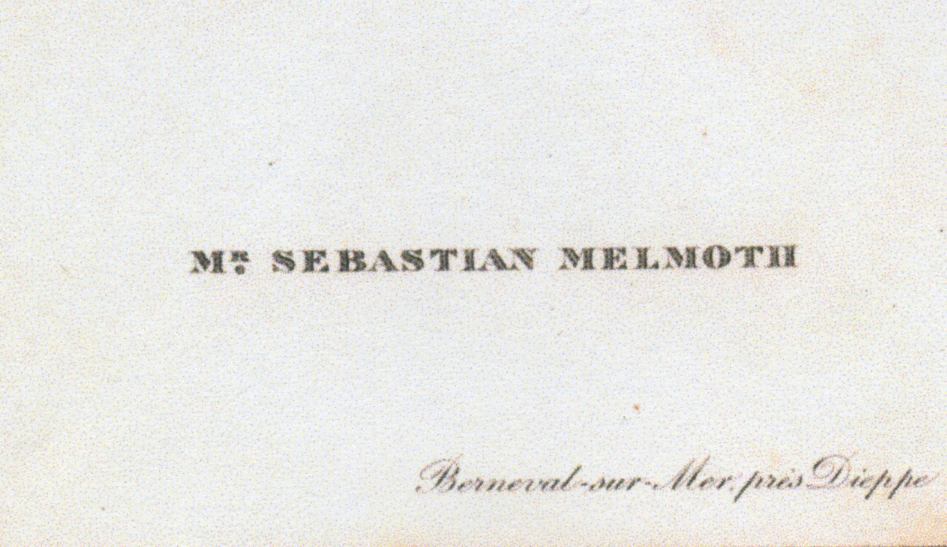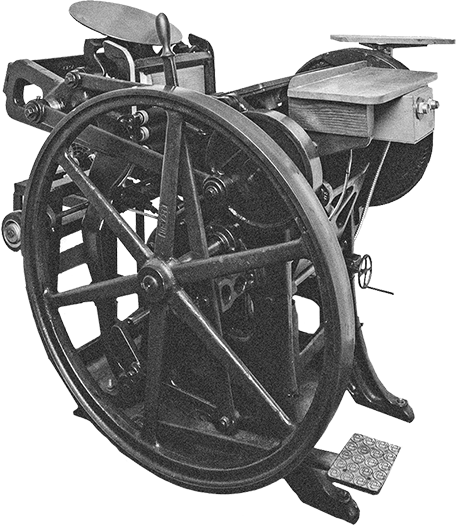Calling Cards and Visiting Cards: A Brief History
by Claire Green -Calling cards, also called visiting cards, visiting tickets, or compliments cards, originated in their paper and ink form in France in the 18th century and their popularity quickly spread across Europe and the United Kingdom.
 Oscar Wilde's rather simple calling card from 1897. The card displays the name he used while traveling after his release from prison. Image source from Wiki Commons
Oscar Wilde's rather simple calling card from 1897. The card displays the name he used while traveling after his release from prison. Image source from Wiki Commons
Calling cards were an indispensable accessory to fashionable, upper class life in Britain, Europe, and the eastern United States during the 19th and early 20th centuries. Though they started as simple unadorned cards to announce one's arrival, the Victorians took both the cards' designs and rules dictating usage to extravagant heights. New printing technologies allowed for more colorful and decorative card designs, which were fully embraced by the “more is more” sensibilities of the mid to late 19th century. Calling cards fell out of favor in the early 20th century as penny postcards became popular and the Victorian celebration of embellishments gave way to simpler, more structured design.
The earliest uses of calling cards, or at least something like them, reach as far back as the ancient Egyptians, who left ceramic tiles in their temple of worship. The tile depicted its owner’s name and title. Calling cards, also called visiting cards, visiting tickets, or compliments cards, originated in their paper and ink form in France in the 18th century. Their popularity quickly spread across Europe and the United Kingdom. Calling cards soon became essential social accessories for the fashionable and wealthy, and served both as utilitarian objects and status symbols. Leaving one's calling card at a friend's home was a way to express appreciation for a recent dinner party, offer condolences for an illness, or simply to say hello. If the recipient “wasn't home” a servant would accept a calling card or the card would be left in a silver tray in the entrance hall. A tray full of calling cards was like social media for the Victorian era, a way to advertise who was in one's extended social circle. Often the cards of the wealthiest or most influential people were purposefully displayed at the top of the stack to impress future visitors.
 Image source from the American Antiquarian Society
Image source from the American Antiquarian Society
The Victorian etiquette of leaving and accepting calling cards was a complicated web of strict rules; to go against these rules could mean social suicide. It was traditionally the obligation of the upper class woman to deliver and accept calling cards, though she could leave her husband's card for the master of the house, along with two copies of her own (one for the master and one for the mistress of the house). Calling with a card at the right time and in favorable circumstances could lead to an invitation to visit. These visits were strictly formalized as well, usually consisting of twenty minutes of polite conversation and allowed only during set times in the late morning or early afternoon. After a call was made, a return call was to be expected and the process continued.
 Simple calling card with handwritten note on back, unknown author. Image sourced from Maria Grace's blog post "Morning Calls and Formal Visits: Socializing in the Regency Era"
Simple calling card with handwritten note on back, unknown author. Image sourced from Maria Grace's blog post "Morning Calls and Formal Visits: Socializing in the Regency Era"
Sometimes short messages were written on the card, to specify the meaning of the visit. A lady might write her seasonal visiting hours on her card, or add that tea would be served at a designated time. Coded messages could be left by folding a corner of the calling card: one corner might express condolence, another congratulations. The rules about corner folding shifted with the times and by the end of the 19th century corner folding was considered passe.
The historical writings about calling cards tend to focus less on the craftsmanship of the cards in favor of the intricate social rules governing their use. But the cards themselves are fascinating pieces of history as well, and reflect the values and changing technologies of their times. The earlier calling cards of the late 18th and early 19th centuries were fairly minimal in their design. Usually, they presented an unadorned handwritten name on white or cream colored stock. The cards were smaller and narrower than the lavish Victorian cards, as they carried less information and little to no decorative elements. However, with the rise of a newly wealthy class and technological advancements in the printing industry, calling cards with maximum ornamentation became the ideal.
 An excellent example of a hand flourished card done by a calligrapher, circa 1840's. Photo by Amy Dinstel - daysofelegance.com
An excellent example of a hand flourished card done by a calligrapher, circa 1840's. Photo by Amy Dinstel - daysofelegance.com
 A very fancy Victorian card featuring popular romantic images in full color, a scalloped boarder and hand sewing with multi colored threads. Photo by Amy Dinstel - daysofelegance.com
A very fancy Victorian card featuring popular romantic images in full color, a scalloped boarder and hand sewing with multi colored threads. Photo by Amy Dinstel - daysofelegance.com
 Several examples of brightly colored fan shaped calling cards. Note that names could be handwritten or printed. Photo by Amy Dinstel - daysofelegance.com
Several examples of brightly colored fan shaped calling cards. Note that names could be handwritten or printed. Photo by Amy Dinstel - daysofelegance.com
Victorian calling cards were large and could be extremely ornate, with the names usually printed instead of handwritten. Women's cards were squarish and fairly large, usually about 2.5 x 3 inches. Men's cards were smaller and more rectangular, meant to fit in a breast pocket, while women often carried their cards in specially made cases of silver, tortoiseshell, ivory, or mother-of-pearl. Most cards displayed a name and title, sometimes the name of a house or district was included as well. The invention of chromolithography made cards with color photos and embellishments possible. Romantic and nostalgic imagery was popular, often featuring doves, young women, kittens, hearts, or delicate hands in full pastel color.
The advent of lithography opened up the possibilities of what could be printed. Rather than setting wood or metal type by hand and being restricted by the grid that ruled the letterpress printer, the lithographer was free to paint and write freehand onto a stone from which the prints were pulled. This new freedom allowed for a style of printmaking that had never been seen before and all the previous rules about design and printing were, at least temporarily, thrown out the window. Threatened by and perhaps a bit jealous of lithography, letterpress printers began experimenting too, in a movement deceptively referred to as Artistic Printing. Bold colors, garish typefaces, and trompe l'oeil illusions, were all embraced by letterpress printers in an effort to compete with lithography. Rule bending was a signature trick of the artistic printer, where long thin pieces of rule traditionally meant to print a straight line, were bent and shaped into fanciful swirls and spirals, then painstakingly set into the grid based lockup in the press bed. All these new and exciting ways to print, paired with an ornamentation-loving culture, resulted in very showy calling cards. In addition to the exotic, full color printing, the cards were further embellished with gilded edges, cloth fringe, hand scalloped borders, edges sewn with decorative ribbon, attached photographs, and even paper flaps that when lifted revealed a hidden name or message.
 Another example of a brightly colored card with standard Victorian imagery, this one with highly intricate pink fringe. Photo by Amy Dinstel - daysofelegance.com
Another example of a brightly colored card with standard Victorian imagery, this one with highly intricate pink fringe. Photo by Amy Dinstel - daysofelegance.com
 A man's Victorian era calling card, with attached photograph. Photo by Amy Dinstel - daysofelegance.com
A man's Victorian era calling card, with attached photograph. Photo by Amy Dinstel - daysofelegance.com
 An early Vicotrian card featuring hand tinted etchings and calligraphy. Photo by Amy Dinstel - daysofelegance.com
An early Vicotrian card featuring hand tinted etchings and calligraphy. Photo by Amy Dinstel - daysofelegance.com
The calling card started as a simply written name on a plain card before evolving into a highly embellished, full color art piece. Both the simple Regency era cards and the lavish Victorian designs can be appreciated as the carefully crafted and lovingly shared objects they were. In today’s world the calling card has all but been replaced by the standard business card. But for hundreds of years, and no matter what the style, a calling card has remained an appreciated and memorable way to establish or strengthen a relationship between people.
Despite the visual difference, the core sentiment remains the same: a well made, thoughtfully designed paper card exchanged to establish or strengthen a relationship between people. Here at Hoban Cards, we drift to the decidedly minimal side of the aesthetic spectrum, but the history of calling cards in the Victorian era is still intriguing and inspiring. And at the heart of it all, the sentiment of exchanging a well crafted card is the same. Whether the calling card offered boasts seventeen colors, flourished hand calligraphy, and fancy scalloped fringe or it is a neatly presented name and phone number printed in the center of a clean pearl white card, the message it conveys is one of respect and appreciation. A well made calling card given to a close friend, colleague, or new acquaintance adds an element of generosity, good will and esteem. This is the tradition of calling cards we are pleased to continue in today's world.
Sources
- Ayiter, Elif. "The History of Visual Communication - Breaking the Grid." The History of Visual Communication - Breaking the Grid. N.p., n.d. Web. 31 Aug. 2016.
- Banfield, Edwin. "Chapter 1: Cards." Visiting Cards and Cases. Trowbridge, Wiltshire: Baros, 1989. 1-9. Print.
- Holland, Evangeline. "The Etiquette of Social Calls & Calling Cards." Web log post. Edwardian Promenade. N.p., 01 Feb. 2008. Web. 19 Aug. 2016.
- "The Etiquette Of Visiting Cards." History And Other Thoughts. N.p., n.d. Web. 31 Aug. 2016.
- Grace, Maria. "Morning Calls and Formal Visits: Socializing in the Regency Era." Web log post. Morning Calls and Formal Visits: Socializing in the Regency Era. English Historical Fiction Authors, 10 Aug. 2013. Web. 07 Sept. 2016.
- Holland, Evangeline. "The Etiquette of Social Calls & Calling Cards." Web log post. Edwardian Promenade. N.p., 01 Feb. 2008. Web. 19 Aug. 2016.
- Hoppe, Michelle. "Calling Cards and the Etiquette of Paying Calls." Calling Cards and the Etiquette of Paying Calls. Literary Liaisons, Ltd., 2000. Web. 19 Aug. 2016.
- Melissa. "Calling Cards - Story and History." Web log post. Story and History. N.p., 18 Mar. 2009. Web. 31 Aug. 2016.
- Rothenberger, Shannon, and Alice Wong. Victoria Calling Cards: Creating Beautiful Business and Calling Cards. New York: Hearst, 1992. Print.
- Tafoya, Renée Claire. "The Victorian Era." Web log post. Graphic Design History. Northwest College Graphic Design, 01 Feb. 2012. Web. 31 Aug. 2016.
- "Victorian Calling Cards." Victorian Calling Cards. Up to the Moon, 04 Sept. 2011. Web. 31 Aug. 2016.

Thanks for Reading!
We not only love writing about letterpress, typography, and design – we're printers ourselves! We've chosen to carry on the tradition of letterpress printing by offering beautifully pre-designed cards at affordable prices.